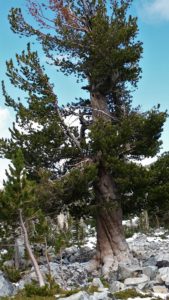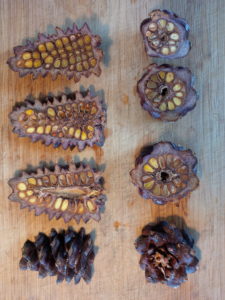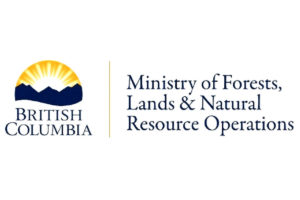Whitebark Pine Genome Project
The Whitebark Pine Ecosystem Foundation, in its leading role in the National Whitebark Pine Restoration Plan, has begun an ambitious program to restore whitebark pine stands in core areas throughout the western United States. Whitebark pine is threatened by the introduced pathogen white pine blister rust (WPBR) and maladaptation due to changing climate. Key components of restoration are to (1) select trees that are genetically resistant to WPBR and (2) to identify trees within stands that are ecotypically adapted and furthermore, adapted to predicted future climates. Cones are collected from selected trees for deploying seeds directly or growing seedlings in nurseries and planting seedlings. Resistance to WPBR in selected trees must be confirmed by a time consuming (2-3 years) and relatively expensive (~$1200/tree) process that involves artificial inoculation of seedlings in greenhouses or nurseries.
Here, we are pleased to announce the Whitebark Pine Genome Initiative. A genomic approach to screening for WPBR would fast-track work and only require collecting small amounts of needle tissue from selected trees and then analyzing the DNA sequences of that tree. This process might take just a few weeks to complete and at a cost of less than $100/tree. However, before this approach can be applied the relationship between genetic variation and disease phenotypic variation must be known (Genome Wide Association Studies).
The guiding principle for ensuring trees will be well-adapted is use of geographic ecotypes. This principle is based on the well-established knowledge that tree populations are spatially adapted to variation in the environment. Application of this principle ensures greater restoration success by not deploying genetically maladapted seedlings or seeds. However, another well-established principle from many years of forest genetics research is that the within population component of genetic variation far exceeds the between population component. Therefore, even though the average genotype within a population is usually best adapted to the environment of that population, there are many genotypes on the tails of the distribution of genotype variation that are less well adapted to the current location and may in fact be better adapted to the environments of different populations. The way to overcome this problem is to have precise DNA sequence information about the adaptive potential of individual trees within a population. This information could be obtained at the same time WPBR resistance was evaluated by DNA sequence and at no additional cost. Again, before this approach can be applied, the relationship between genetic variation and environmental variation must be known (Environmental Association Analysis).
The genome initiative proposed here will develop the genomic technology to apply DNA sequence evaluation of selected trees as seed sources for WPBR resistance and ecotypic adaptation. The basic research program has two major components that would be conducted over a 2 to 3 year period.
- Obtain a well-annotated reference genome sequence for whitebark pine.
- Conduct genome wide association studies and environmental association analyses to identify WBPR resistant and ecotypically adapted trees, respectively.
The genome initiative will be coordinated by David Neale, Ph.D. (emeritus Distinguished Professor University of California, Davis and affiliated scientist of the WPEF) and an experienced team of genome scientists from Johns Hopkins University, University of Connecticut, Northern Arizona University, and the British Columbia Ministry of Forests. The estimated time to complete the discovery project is 2-3 years and at an estimated cost of ~$600, 000 (the US Forest Service has already committed $77,000).
The restoration plan for whitebark pine must encompass broad geographic regions and large areas within these regions to be effective. Working with the best technologies available will increase efficiency and greatly reduce costs. The Whitebark Pine Genome Initiative will facilitate reaching restoration goals.
For more information contact Dr. David Neale at [email protected] or 603-617-6813
Learn about our other genome projects:
Bristlecone Pine Genome Project









